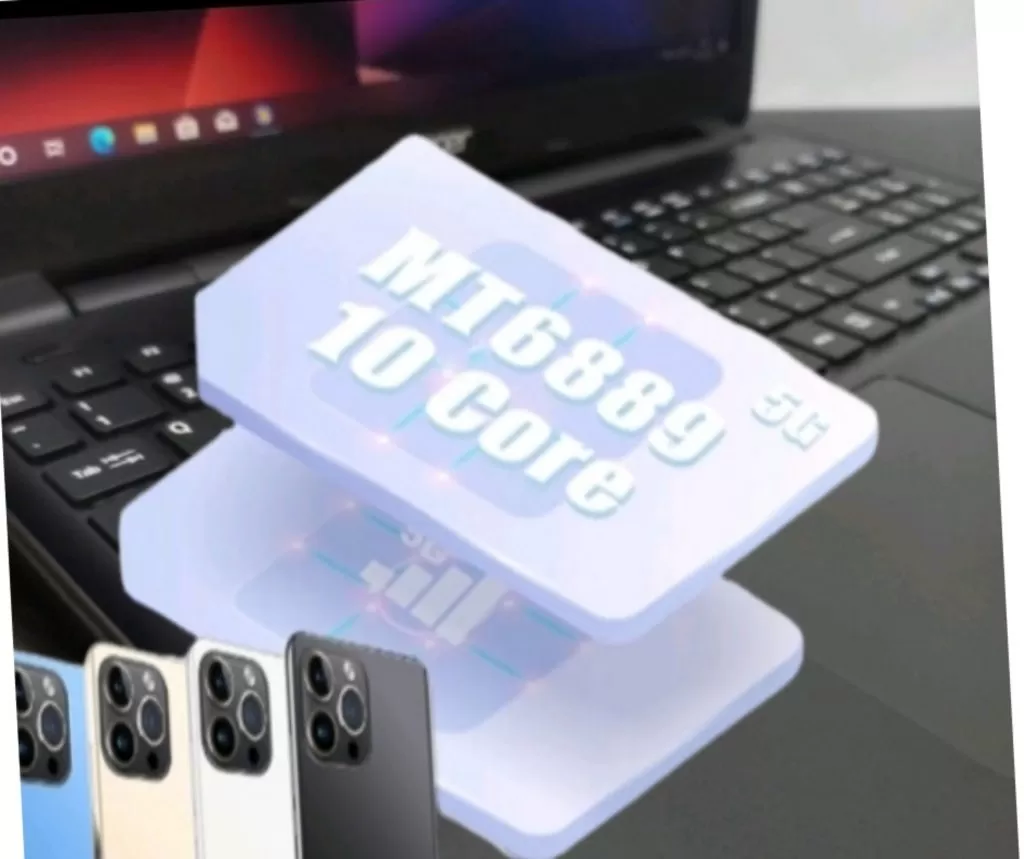Multymeter.com–Digital Products: It’s very important to know the Processor, RAM, and ROM on a smartphone, computer, or laptop device. Because the purpose of buying these devices is to help our work. So don’t make the wrong choice that slows down its performance.
1. RAM
The main function of RAM is to speed up data processing on the device. So if the greater the RAM capacity installed, the faster the device will work. Not only that, but also the function of RAM.
• Can store data originating from incoming devices until the data is sent to the Arithmetic Logic Unit (ALU) for processing.
• Can be used to store ALU processing result data before it is sent to the output device.
• Can accommodate programs or instructions originating from input devices or from secondary memory devices.
• Can speed up the processing of data.
TYPES OF RAM
1.DYNAMIC RAM (DRAM)
Dynamic RAM are types of RAM that are regularly refreshed or refreshed by the Central Processing Unit (CPU) so that the data contained in them is not lost.
The advantage of this D RAM is its structural simplicity as it only requires one transistor and the required capacitor per bit, compared to the four transistors of S RAM.
2. SD RAM
Sychronous Dynamic Random Access Memor atau SDRAM merupakan RAM lanjutan dari DRAM. Namun jenis-jenis RAM ini telah mengalami sinkronisasi oleh clock sistem. Umumnya, SDRAM lebih cepat dibandingkan DRAM.
The speed of this RAM can reach 100 to 133 MHz. The characteristics of the SD RAM itself are that there are two gaps in the legs and are placed in the DIMM / SD RAM slots on the motherhood, and can accommodate up to 1 GB of memory.
3. DDR RAM
Double Rate Random Access Memory or DDR RAM are types of RAM with advanced technology from SD RAM. RAM is capable of executing two instructions at the same time in the same unit of time. This type of RAM has a capacity of 184 pins and consumes less power.
DDR RAM also has the latest generation, namely DDR2 and DDR3 and DDR4 which are developments from DDR RAM. This type of RAM is widely used in laptops in order to save electricity and get more leverage at high speed. For this type of memory capacity is quite large, up to 16 GB per chip.
4. RD RAM
Rambus Dynamic Random Access Memory or RDR RAM is faster and generally more expensive than SD RAM. This type of SD RAM is used on computer devices that use Pentium 4 with memory slots up to 184 pins.
This type of RAM uses the same RIMM slot as SD RAM. Is a dynamic chip technology made by Rambus, Inc. It has a special license for semiconductor technology that produces chips.
5. S RAM
Static Random Access Memory or S RAM are types of RAM that can store data in it without having to refresh or refresh from the CPU. This type of RAM has a faster working process than D RAM and SD RAM.
Has a six-transistor cluster design that is useful for storing every bit of information. It’s this design that makes S RAM both more expensive and faster. Yes, physically the chip, the chip manufacturing costs are approximately 30 times greater than D RAM. But unfortunately, S RAM has a drawback, namely the production costs are even. This makes the supply only in small capacity and used for the part that is really important.
6. EDO RAM
Extended Data Out Random Access Memory or EDO RAM are types of RAM that are used on devices with Pentium OS and are suitable for installation on computers with bus speeds up to 66 MHz. This type of memory can store and retrieve data at the same time.
This type of memory is widely used to replace the existing primary memory on earlier computers, namely FPM RAM. Because it can store and read simultaneously, the read-write speed on EDO RAM can be faster too.
7. NV RAM
Non Volatile Random Access Memory or NV RAM is a type of computer memory with random access which is usually used to store configurations made by firmware such as EFI, BIOS, or other firmwares on embedded devices such as routers.
In general, NV RAM is designed with CMOS manufacturing so that the power required is also small. To turn it on so that stored data is not lost, NV RAM uses a Lithium battery with CR-2032. Data stored in this memory will not be lost even if the power is turned off.
2. ROM
ROM serves to store boot data. The saved codes will be used when the device starts up. Without this data, it is certain that the device cannot operate normally.
Apart from storing the boot code, ROM can be used to back up files. ROMs are generally equipped with a high level of security so they are not easily exposed to any viruses. If you want to do this, just copy the file or files to a PROM type CD-R.
Not only that, ROM is also often used as a tool for distributing software (software). The use of ROM as an intermediary for software installation is arguably very popular because it is more robust and durable. This method is even able to minimize the occurrence of damage during the installation process. Therefore, it’s no wonder that most people prefer ROM over other storage media.
ROM form
At the beginning of its appearance, ROM consisted of a number of integrated circuits equipped with transistor switches and physical data. This causes ROM to be purely read only, only readable and impossible to modify. This setting is the factory default and becomes the default memory chip.
Over time, ROM technology continued to be developed until 1990 found flash memory. This discovery is able to boost the performance and quality of ROM, especially when the power is turned off. Until now, flash memory is used as standard ROM on PC and smartphone devices.
Understanding About Processor in Smartphone
The processor or also called the Central Processor Unit (CPU) is the most important part of every device with the task of controlling every component in a smartphone device. This processor becomes the brain or center of all performance that operates within the device.
The processor in a smartphone device is different from that in a PC. The chipset on a mobile device is also known as System-on-a-Chip (SoC), which means a silicon chip which consists of all the components in it. Like a calculator with a function only as a data processor received via input, then it will produce output.
Many smartphones now feature Processor Clock Speed thus making them in great demand. Especially for Android smartphones that now have various processors.
Difference Between Computer Processor and Smartphone
I think it’s no stranger to hearing smartphones because these smart phones are already very popular among the public. These phones are moving fast because smartphone phones with the Android operating system were introduced in 2007, moreover, there are several cellphones that have quad-core processors with a speed of 2.5 GHz, such as Sony Xperia Z2, LG G3, and others.
With a very impressive processor capability on this smartphone, it is not much more powerful than an Intel Core i3 computer processor which has a GHz clock that is far below it. The number of cores in the GHz scale is not the only indicator in determining the ability of the processor.
- TDP
TDP stands for Thermal Design Power. The meaning of TDP is that smartphones in general have components that are small and sensitive to heat, to reduce energy consumption and heat effects, the processor will be designed with a low TDP.
- Program Scale
Processors on smartphones are designed with a small physical size (Fab Size) with a small TDP (Thermal Design Power) so that they are only able to run programs on smartphones that do have a small program scale, therefore the GHz scale on smartphones and computers cannot compared because they have different segments and work scales.
- Other Supporting Components
RAM is also very influential, because RAM compatibility on the most sophisticated smartphone processors only has a 32-bit instruction set with a bandwidth of 12.5 Gb/s, while computers can reach 36 bits with a bandwidth of up to 21 Gb/s.
- Limited performance
the processor on a smartphone rarely reaches the highest speed because it avoids overheating or saves the battery, if it exceeds it can cause permanent damage because there are some components that melt due to heat.
Processor Levels on Smartphones
After knowing what an HP processor is, here is a collection of the best HP processors. This processor level follows the processor manufacturers that can be found on the market.
If users want to buy an Android cellphone, make sure to choose the right processor according to the level below.
1.Snapdragon Processor tier
Snapdragon 800 Series. The series that have been released to date include: Snapdragon 800, 801, 805, 808, 810, 820, 821, 835, 845, 855, and 855+.
Snapdragon 700 Series. The series that have been released include: Snapdragon 710, 712, 730 and 730G.
Snapdragon 600 Series. Series that have been released include: Snapdragon 600, 610, 615, 616, 617, 625, 626, 630, 650, 652, 653, 632, 636, 660, 665, 670, and 675.
Snapdragon 400 Series. Series that have been released include: Snapdragon 400, 410, 412, 415, 425, 427, 430, 435, 429, 439, and 450. Snapdragon 200 series. Series that have been released include: Snapdragon 200, 205 , 208, 210, 212, and 215.
2.Exynos Processor Tier
Exynos 3 Single (3310) Exynos 4 Dual (4210)Exynos 4 Dual (4212)Exynos 5 Dual (5250)Exynos 4 Quad (4412)Exynos 5 Octa (5410)Exynos 5 Octa (5420)Exynos 3 Quad (3470)Exynos 5 Hexa (5260)Exynos 5 Octa (5422)Exynos 7 Octa (7580)Exynos 5 Octa (5430)Exynos 5 Octa (5433)Exynos 7 Octa (7420)Exynos 7 Dual (7270)Exynos 7 Quad (7570)Exynos 7 Octa (7580)Exynos 7 Octa (7870)Exynos 8 Octa (8890)Exynos 7880Exynos 7872Exynos 7884Exynos 7885Exynos 7904Exynos 8895Exynos 9609Exynos 9610Exynos 9611Exynos 9810Exynos 9820Exynos 9825Exynos 980Exynos 990
3.MediaTek Processor Tiers
Here are several levels of HP processors and also the order that is popular on smartphones that are already circulating on smartphones:
Helio A Series: Helio A20 and Helio A22 (MT6761)Helio P Series: Helio P10, Helio P15, Helio P18, Helio P20, Helio P22, Helio P2, Helio P25, Helio P30, Helio P35, Helio P60, Helio P65, Helio P70, Helio P90.Helio X Series: Helio X10, Helio X10 M, Helio X10 T, Helio X20, Helio X20 M, Helio X23, Helio X25, Helio X27, Helio X30.Helio G Series: Helio G90 and Helio G90T.* **






